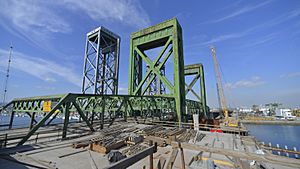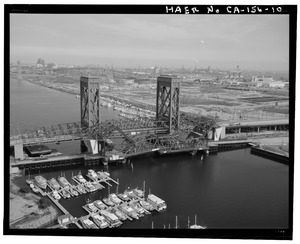Commodore Schuyler F. Heim Bridge facts for kids
Quick facts for kids Commodore Schuyler F. Heim Bridge |
|
|---|---|

Schuyler Heim Bridge (1948), foreground (green structure); and Henry Ford Bridge (1996), background (gray structure). Photographed in 2014, during construction of the replacement road span.
|
|
| Coordinates | 33°45′58″N 118°14′23″W / 33.766111°N 118.239722°W |
| Carries | |
| Crosses | Cerritos Channel, Port of Los Angeles |
| Locale | Wilmington, California |
| NBI | 53-2618 |
| Characteristics | |
| Design | Through-truss vertical-lift bridge |
| Total length | 700 ft (210 m) (4,000 ft including approach viaducts) |
| Width | 81 feet (25 m) (including 75 ft for the six traffic lanes) |
| Height | 236 feet (72 m) tall (186 ft (57 m) above roadway) |
| Longest span | 240 feet (73 m) |
| Clearance below | 175 feet (53 m) fully raised |
| History | |
| Opened | January 10, 1948 |
| Closed | October 12, 2015 |
| Lua error in Module:Location_map at line 420: attempt to index field 'wikibase' (a nil value). | |
The Commodore Schuyler F. Heim Bridge was a special kind of bridge called a vertical-lift bridge. It was located in the Port of Los Angeles. Opened on January 10, 1948, this bridge helped State Route 47 (also known as the Terminal Island Freeway) cross over the Cerritos Channel.
The bridge was named after Schuyler F. Heim. He was in charge of the Naval Air Station on Terminal Island in 1942. The Heim Bridge was one of the biggest vertical-lift bridges on the West Coast. When it first opened, it was the highest in the country. Its main part, called the deck, weighed about 820 tons. The tall towers of the bridge stood about 186 feet (57 meters) above the road. From the water, they were about 236 feet (72 meters) tall.
The bridge was taken out of service on October 12, 2015. A new, six-lane fixed-span bridge was built to replace it. This new bridge helps meet modern safety and earthquake rules. The replacement bridge, called the State Route 47 Schuyler Heim Bridge Replacement, was finished in September 2020.
Contents
Exploring the Schuyler Heim Bridge's History
Early Connections to Terminal Island
Long ago, people wanted to connect Terminal Island to the mainland. In 1887, a railroad company started building a line. This line went from what was then called Rattlesnake Island (now Terminal Island).
Over time, more ships used the port. This meant the channel needed to be wider. In 1914, there were plans to make Cerritos Slough 1,000 feet (305 meters) wide. This would connect the Port of Los Angeles to the Port of Long Beach. A wider channel meant the old railroad bridge from 1908 had to be moved. After many talks, a plan was agreed upon.
Even with these early train bridges, people on Terminal Island really wanted a road bridge. They had asked for a wagon bridge as early as 1894.
The 1948 Schuyler Heim Lift Bridge
In 1924, work also began on a Naval Air Base at Terminal Island. More and more ships came to the port. The United States Navy also grew its presence on Terminal Island in the early 1940s. This included making the air base bigger.
The Navy's expansion plans needed more workers. The existing Henry Ford Bridge couldn't handle all the traffic. So, in 1941, the Navy asked for a new road bridge to be built. Construction on the Schuyler Heim Bridge started in 1946. It was named after Commodore Schuyler Franklin Heim. He was the commander of the Naval Air Station on Terminal Island in 1942.
The state of California took over running the bridge from the city of Los Angeles in 1964. By 1988, the bridge was being lifted very often. It was raised about 8,500 times each year to let ships pass.
Building the New Fixed-Span Bridge
The State Route 47 Schuyler Heim Bridge Replacement project built a new fixed-span bridge. This new bridge replaced the part of the old bridge that used to lift up. The new bridge has six lanes for cars and trucks. There are three lanes going in each direction. The entire new bridge is about three-quarters of a mile long.
This new bridge allows ships to pass underneath all the time. It has a clear space of 180 feet (55 meters) wide. The vertical clearance, or height for ships, is 47 feet (14 meters). Construction was supposed to finish in early 2017. However, it was delayed until late 2020.
Even though the new bridge has less vertical clearance (47 feet compared to 165 feet when the old bridge was raised), the old lift bridge couldn't handle very large cargo ships anymore. Work on the replacement bridge started in 2011 and was completed in September 2020.
How the Schuyler Heim Bridge Was Designed
The road surface, or deck, of the old bridge had an open grid design. This made it lighter. A lighter deck was easier to lift for ships to pass underneath. The bridge used more than 400 tons of counterweights. These weights helped lift the deck section. This allowed tall ships to go under the bridge.
State Route 47 and State Route 103 are very busy roads. Many trucks use them to avoid the crowded Interstate 710 freeway. Because so many heavy trucks drove over the bridge, its deck wore out quickly.
The deck was completely replaced in 1997. But it was still under a lot of stress from the heavy traffic. The California Department of Transportation (Caltrans) tried something new. They put in eight test panels made of fiber reinforced polymer (FRP). They also added sensors to these panels. These sensors checked how much stress the panels could handle. They also measured how much weight they could bear and how temperature affected them. This helped Caltrans decide if FRP could be a good permanent replacement.


